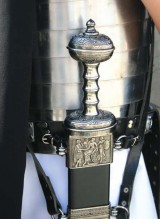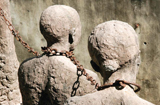How do you approach emotional subjects like slavery and WWII in the classroom?
There is nothing historians like more than a good controversy. Regular viewers of Channel 4’s Time Team see the historians and archaeologists revel in their disagreements about where to dig next, or the meaning and significance of a small piece of mud-caked pot.
Having a variety of views on something is the very thing that makes history interesting. And in the TEACH report – commissioned by the History Association - a group of teachers and academics consider how emotive and controversial history can be approached in schools. They examine the opportunities and constraints upon teaching elements of the past which are likely to cause debate in the classroom, and make suggestions on how teachers can broach these sometimes sensitive subjects.
The report begins with the following definition of what constitutes emotional or controversial history:
“The study of History can be emotive and controversial where there is actual or perceived unfairness to people by another individual or group in the past. This may also be the case where there are disparities between what is taught in school history family/community histories and other histories. Such issues and disparities create a strong resonance with students in particular educational settings.”
 The report identified a number of reasons why primary teachers might want to teach emotive and controversial topics in history, and why it might support good quality history teaching:
The report identified a number of reasons why primary teachers might want to teach emotive and controversial topics in history, and why it might support good quality history teaching:
The primary curriculum, especially at KS1, is flexible enough to allow teachers to choose their own topics to some extent. Often, teachers enjoy teaching things they have selected themselves more than something which is prescribed for them. This works especially well with local history studies, where teachers can follow their own and pupils’ interests through learning about the history on their doorstep in the places and the buildings and the people in the local community.
Good quality history teaching has a strong focus on enquiry skills and cross curricular work, both of these are supported by emotive and controversial history when pupils discuss, debate and form their own opinions.
By definition, emotive and controversial history teaching requires both teachers and pupils to engage in an emotional way with the subject matter. Everyone in the classroom needs to feel comfortable about this, and able to say whether something they are learning about makes them feel angry or sad. Emotionally secure classrooms where this can happen are good places to learn and promote pupils’ personal, social and emotional development.
There are some good quality and interesting resources, especially books, which teachers can use as a basis for their teaching. Teachers should consider using both stories themselves and the pictures on their own to promote debate.
 The report also identified problems and constraints of taking this approach to history teaching:
The report also identified problems and constraints of taking this approach to history teaching:
• History is sometimes a ‘bit part player’ in a curriculum where literacy and numeracy dominate. Some teachers may not be able to allocate enough time to history to teach it in such an innovative way.
• It is sometimes worrying to teach so called ‘tricky’ topics which address issues such as immigration or war. It is easier to play safe by glossing over difficult aspects of topics and concentrating on less controversial topics. This is evident at KS2, where World War 2 is often taught through the topic of evacuees. Some materials present the evacuation as something akin to a nice holiday in the country for children, whereas the reality that being moved away from home to a strange place leaving Mum and Dad facing bombs aily in the city must have been a very traumatic experience for children. This is not to say that the teachers should not try to avoid aspects of history which may be too distressing for their pupils, but rather teachers should make sure the picture painted is as realistic as possible. Most children will identify with history which is about other children, and empathise readily.
• Schools understandably tend to select topics for which they can get good quality resources, it is very time consuming to find and prepare new resources. This sometimes leads teachers to have to teach the same subjects year after year because the books are available. This has certainly happened in the case of Florence Nightingale, who has become popular in schools in a way that is disproportionate to her actual historical importance!
This is the big question for you as a teacher: is it worth tackling the constraints in order to take the opportunity to teach in this way? I would argue that it is. For me, the best thing about history is that it provokes debate and makes teachers and pupils reflect. Really authentic learning experiences are often those which promote emotional and personal engagement with a topic. In addition, where pupils feel their teacher is enthusiastic and really wants to hear their views, however diverse, on a topic, they tend to engage more readily in the learning. In short, where good history teaching is emotive and controversial, it is absorbing and stimulating for learners.
Stories are central to children’s developing understanding of the world around them and its history. They also introduce pupils to a range of emotions in a way which enables them to talk about feelings without it being too threatening. Teachers might use traditional and familiar tales to explore this with young children. For example, how did the bears feel when Goldilocks stole their porridge? Were the pigs frightened by the big bad wolf? And did he deserve what he got? Once children are used to discussing characters and stories in this way and have built up their thinking skills, they could move on to story and picture books which link to their history topics. For example, during the KS1 topic of Toys, children could look at books their parents might have read and children. This could include classics such as The Very Hungry Caterpillar, Each Peach Pear Plum and Dogger. All of these books are good to inspire debate amongst children and memories of family history from parents.
KS2 books can again be useful starting points for considering emotional and controversial history topics. During a World War 2 project, Michael Foreman’s book War Boy provides some useful images and stories about life for a child during the war. It might also be useful to look at other children’s perspectives on the war, using Ian McEwan’s book Rose Blanche or Ruth Vander Zee’s Erica’s Story. In addition, at KS2, strong links with citizenship can be made. As well as providing a context for discussion, aspects of the curriculum that look at British history, such as the Invaders and Settlers topics, can be a starting point for understanding the range and diversity of all pupils’ backgrounds. Looking at how the country grew from its tribal roots through successive invasion and settlement by the Romans, Anglo Saxons and then Vikings is a good way to help pupils consider the history of Britain in the context of its ever changing population. Influences on British culture can also be examined through topic on the Tudors and Victorians, where travel, exploration, trade, cultural exchange and Empire are all important themes.
Teaching emotive and controversial history is not the easy option but it can be thought provoking and motivating for pupils and teachers.
For more on this subject, including subject knowledge, case studies and further reading, download the whole report at the Historical Association’s website (history.org.uk/resources/resource_780.html)
Outstanding schools: RJ Mitchell Primary
Outstanding schools
Use the bottle-flipping craze to create good school behaviour, not bad
Behaviour Management
The side effects of teaching music
Ace-Music
